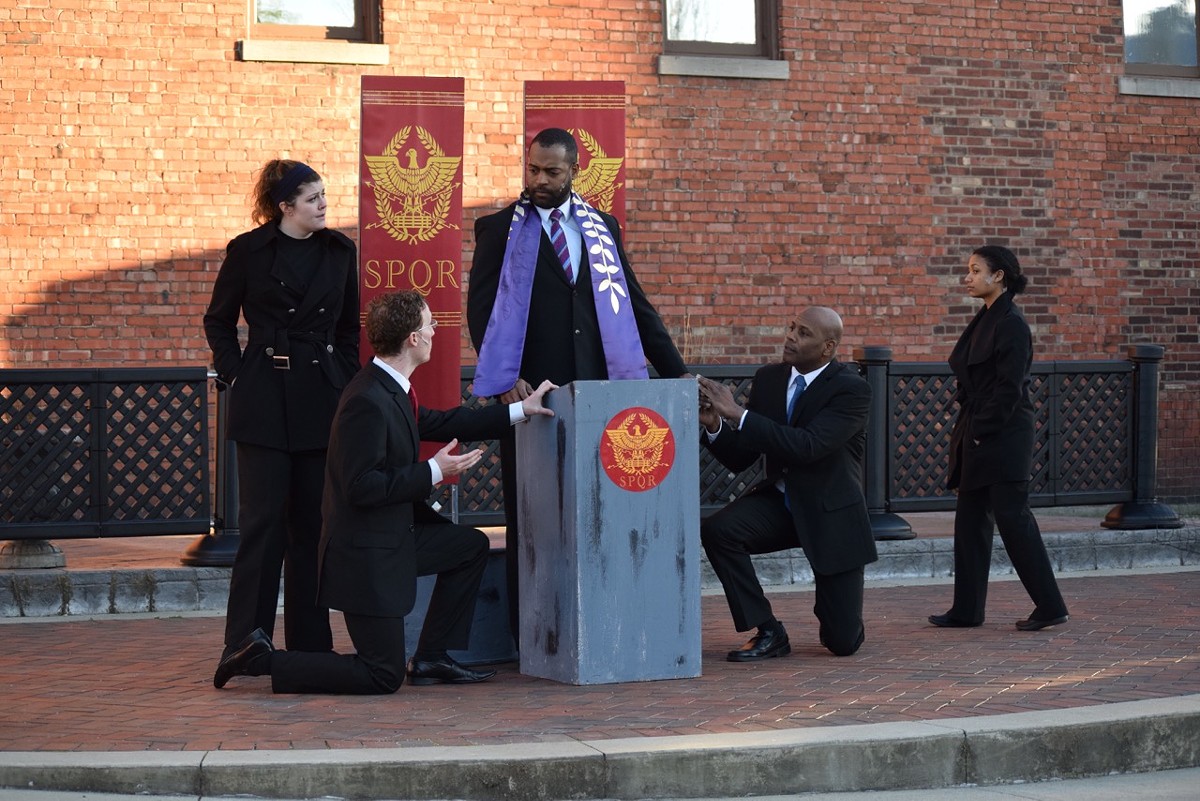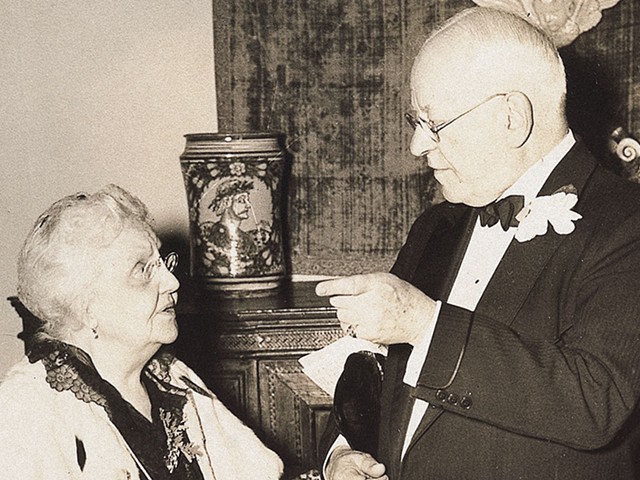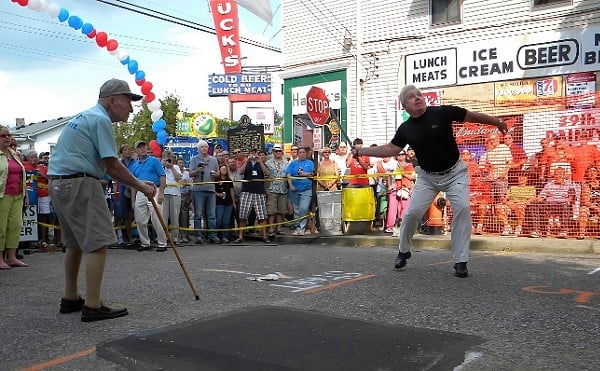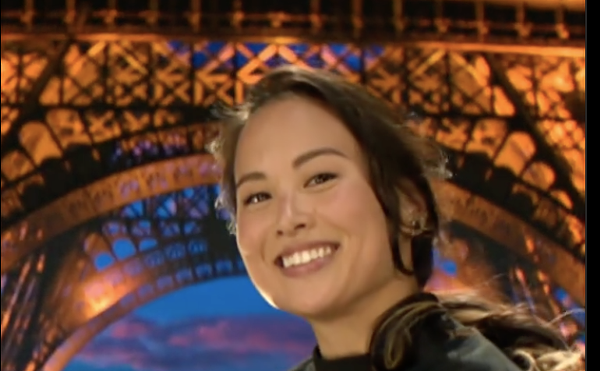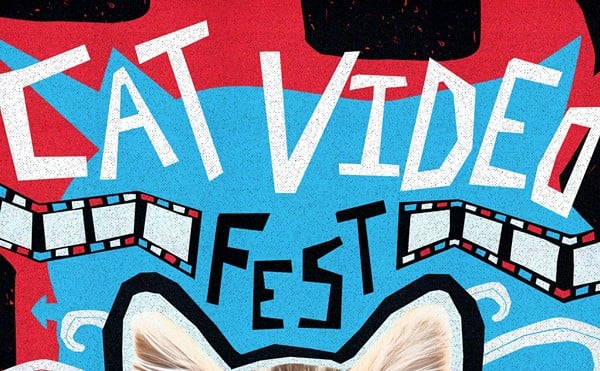I set out to write about the ambitious, fascinating mechanics and logistics of Shakespeare in the Parks tour, which takes a small ensemble to an incredible number of parks, public spaces and theaters across the Commonwealth. And along the way I ran into Male High School teacher Melanie Gosset, who pretty much perfectly encapsulated why these shows need to go on the road.
While her high school sophomore students waited to see the traveling troupe’s “Julius Caesar,” we talked about the importance of seeing Shakespeare onstage. Her class of English students had just finished reading “Julius Caesar” the week before.
“We try to act it out as best we can, and we read most of it out loud in class, and they to animate it, but to see people that have practiced it and understand it, it’ll make it come alive for them.”
It’ll come alive for these kids, but only if they see it.
Now, how it comes alive, and what it takes to get it on stage is a whole other production that the public never sees, in Central Park, or out there somewhere in Kentucky.
In his tenure at the helm of Kentucky Shakespeare, Matt Wallace has overseen an impressive amount of growth. It’s easy to point to the expanded season, the invigorated audience and the new programs including Shakespeare with Veterans, but Wallace has also overseen technical upgrades for the company, including a new main lighting truss and an impressive, new sound system, with sophisticated microphones for the cast, so that their voices boom out to Central Park’s tennis courts, and even beyond.
Another aspect, perhaps less visible to the company’s main audience in the park, is the Shakespeare in the Parks tour. This year’s tour, a stripped-down and modernized “Julius Caesar,” will visit dozens of alternative spaces, offering some people their first glimpse of professionally-produced Shakespeare, possibly the only Shakespeare they’ve ever seen on stage.
This tour spans a couple of months, running in Louisville from late March to mid May.
I caught up with the tour for its first Louisville appearance on March 25, to watch the show and talk to the performers, stage manager and Matt Wallace about the differences between the touring show and the company’s main stage season in the park.
Every park performance on the tour this year has a secondary indoor space booked in case of rain, and the early shows only booked inside gigs, not trusting the fickle weather of March in Kentucky.
It seemed like a smart choice when I arrived at the Union Hall of the The International Brotherhood of Electrical Workers Local 369 in Louisville. Ominous clouds were gathering overhead, and, while the day had started out warm, between the cloud cover and the cold winds, it was too chilly for outdoor theater.
The entire production of “Julius Caesar” has to fit in one van, a big white Ford. It had just pulled up and parked when I arrive. The seven-person cast spilled out of the vehicle to stretch their legs. They travelled here only from downtown Louisville, but the van was jam-packed. The parking lot was empty, except for their van and my little Subaru.
The cast members gave me a quizzical look, as they tried to figure out why I was there. I know most of them from covering them on one project or another, but I’m also a Shakespeare nerd, so it’s entirely plausible that I’m just there for the show.
I approached stage manger Alli Ryan, the nerve center of the touring show. While the actors are in charge of their characters and lines, Ryan is in charge of keeping all the pieces moving in the right direction. There may not be sophisticated technology, but that doesn’t mean there aren’t plenty of logistics to manage.
Exemplifying the bone-thin technical elements, the cast took a couple of items out of the van, a small plywood column and its base, the single speaker they use for music. There’s a little more to the show but not much, and the actors weren’t serious about moving anything around, because they weren’t quite sure where to go yet. On a small scale tour like this, every venue is a new adventure.
Neill Robertson, a regular with Kentucky Shakespeare, talked about the disparities in performance spaces: “One day you’re on a gym floor, and one day you’re in the most beautiful performing arts center that you never knew existed, in Madisonville.”
The wide variety of spaces combined with the cramped space of the van means that the actors are most likely going to have to do without the technical amenities an actor like Robertson may be accustomed to in Central Park. The performance will only have theatrical lighting if it’s on site, and even then the nonexistent rehearsal time will dictate that, at best, the lighting will include one or two basic looks. They may get a bright look and a dim look. If they are in a particularly great venue with its own house technician they may even get a red look and a blue look. But, probably not.
For indoor shows, they are far more likely to be dealing with a gymnasium or gymnatorium, and the lights will consist of whatever harsh fluorescents are in the space. Hopefully, the gym is sophisticated enough that half the lights can be turned off, leaving the audience in darkness. On an outdoor show, they’ll have twilight and maybe a couple of park lights illuminating them as they project their lines without the help of microphones.
Ryan sat calmly in the back of the van waiting, when actor Sabrina Spalding approached and jovially asked: “Are we waiting for Matt? Cause I’m like … are they gonna let us in or something.” It’s a perfect demonstration of Ryan’s role. Spalding assumed Ryan would have all the answers about the when and the where. And she was right. Ryan calmly replied, “We’re early, if it gets to like, 5:15, I’m gonna call Matt.” That was good enough for Spalding, who’s toured shows before with Walden Theatre. She’d worry if and when it’s time to worry.
For this performance, Wallace unsurprisingly joined the cast. To the best of my knowledge, he attends every single performance in Central Park, as well as the company’s new off season gigs in the Kentucky Center for the performing Arts. While he can’t be at every stop on the tour, it makes sense that he’d be at the first local show. The guy seems to genuinely love pretty much every second of his job.
Sure enough, a few minutes later Wallace arrived to coordinate getting the cast inside. It makes for a slightly easier day for Ryan. In a similar situation out on the road she would have had to call someone in the KY Shakes office to double check the tour’s contacts at the venue, and then hunt down whoever was supposed to host the group.
And this all needs to happen in the hour that the company has to prep the space, get the audience seated, and start the show.
When Wallace arrived and the doors to the venue finally unlocked, the load-in started.
Each set piece — several columns, their bases and a single podium — is hollow, and filled with costumes, props and set dressing. There is no room to spare in the van, so solid set pieces would be a waste of space. Not to mention heavy — a bad idea when they need to get moved several hundred, if not a couple thousand times, over the course of the tour.
The cast moves the minimal set into the Union Hall’s largest meeting room with practiced ease. They set the “stage,” one end of the large room, and set up chairs for the audience as well.
In Central Park, the last few days of tech rehearsal consist of epic “10 out of 12s,” a time-honored tradition when actors and technicians rehearse for 10 out of 12 hours several days in a row. Each moment of the play needs to incorporate technical elements and spatial relationships in the park. What exact moment does this spotlight need to turn on? When does this mic go hot? How long does it take an actor to walk from back stage to the back of the house so they can stroll down the aisles, maybe surprising an audience member who hadn’t seen them preparing for their entrance?
On tour, the actors only have a couple minutes to get a feel for the new space before they disappear and the audience starts to show up.
Of course, they’ve still meticulously rehearsed the show. “As far as the process, it’s very similar,” said Robertson. “Matt still treats it with very specific care, the way he does the shows in the summer. There’s nothing different on that end.”
The audience arrived, and it was a young crowd. A lot of high school students, a couple of families.
I asked two young women their names and what they are doing there. After they give me weird looks, I realize that strange middle-aged men asking questions must rightfully raises red flags for teenage girls. I changed tracks, and asked if they have a teacher nearby.
They pointed me toward Gosset.
“Caesar” is a personal favorite of Gosset’s, and she listed all the reasons why it’s so relevant today. Of course, pretty much any Shakespeare can be relevant to a current audience, which is why his plays are still kicking around more than 400 years after his death.
But it’s hard not to see how particularly apt Caesar is these days. “As far as teaching about trust and betrayal… and the whole government — about who you can trust,” said Gosset.
Despite a tendency for people to take sides when talking about politics, “Caesar” is a great example of a piece that doesn’t take sides: “We spend a lot of time on Anthony and Brutus’ funeral speeches.”
Those speeches famously take an angry crowd, and with some persuasive and charismatic words, completely change the crowd’s mind about what is right, and then change it back a moment later. Mob mentality knows no century, and Gosset hopes to teach her students to weigh arguments on their true merits.
“We talk about the appeals [that Brutus and Anthony] use to sway, and why you should be educated so that you aren’t so easily swayed,” Gosset said.
The number of students that show up is pretty impressive, even if they were offered extra credit.
The lights dim, and Wallace makes a speech, thanking the audience for showing and giving shouts out to the metro council member Metro Councilman Dan Johnson of District 21, who helped fund this stop of the tour.
The production of “Caesar” is fast and urgent. The sprawling tragedy is cut down to a quick hour and 15 minutes. The actors are garbed in updated clothing, business suits for Patricians like Brutus, Cassius and Anthony, that give way to Che Guevara looks as the play switches from political speeches to war.
“Caesar” is a part of Kentucky Shakes’ main season in the park this summer, but few of these cast members will be in that production, and those who are will mostly be playing different characters. The updated clothing will go in favor of more traditional Roman garb. The razor-thin cut of the play will be discarded for something that will likely run closer to two or two and a half hours. And the tech will be several orders of magnitude more complicated. Microphones, larger moving set pieces, complicated light cues, an intricate sound design.
I’m sure it’ll be great, but I think part of me will miss the fiery and fast version I saw at IBEW local 169. A show which packed back up into the touring van just as fast as it unloaded.
I heard a common thread among the actors as I interviewed them: A lot of times, many of the kids in the audience don’t care about the play the company is working so hard to show them. But, the actors do their best show anyway. As Ryan put it, “You gotta think about the one kid you’re influencing. That one.” Somewhere out in the dark is a kid who’s rapt. Someone whose life is getting changed, whose whole world is opening up to poetry and theatre.
After all, it doesn’t take a big theatrical production. You don’t need lights and fancy sound effects, or elaborate costumes. Just a couple of actors who are committed to the work, and the words of William Shakespeare.

